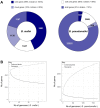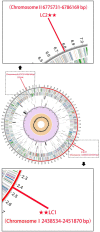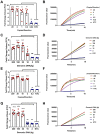Detection of Burkholderia pseudomallei with CRISPR-Cas12a based on specific sequence tags
- PMID: 37250090
- PMCID: PMC10211466
- DOI: 10.3389/fpubh.2023.1153352
Detection of Burkholderia pseudomallei with CRISPR-Cas12a based on specific sequence tags
Abstract
Melioidosis is a bacterial infection caused by Burkholderia pseudomallei (B. pseudomallei), posing a significant threat to public health. Rapid and accurate detection of B. pseudomallei is crucial for preventing and controlling melioidosis. However, identifying B. pseudomallei is challenging due to its high similarity to other species in the same genus. To address this issue, this study proposed a dual-target method that can specifically identify B. pseudomallei in less than 40 min. We analyzed 1722 B. pseudomallei genomes to construct large-scale pan-genomes and selected specific sequence tags in their core genomes that effectively distinguish B. pseudomallei from its closely related species. Specifically, we selected two specific tags, LC1 and LC2, which we combined with the Clustered Regularly Interspaced Short Palindromic Repeats (CRISPR)-CRISPR associated proteins (Cas12a) system and recombinase polymerase amplification (RPA) pre-amplification. Our analysis showed that the dual-target RPA-CRISPR/Cas12a assay has a sensitivity of approximately 0.2 copies/reaction and 10 fg genomic DNA for LC1, and 2 copies/reaction and 20 fg genomic DNA for LC2. Additionally, our method can accurately and rapidly detect B. pseudomallei in human blood and moist soil samples using the specific sequence tags mentioned above. In conclusion, the dual-target RPA-CRISPR/Cas12a method is a valuable tool for the rapid and accurate identification of B. pseudomallei in clinical and environmental samples, aiding in the prevention and control of melioidosis.
Keywords: Burkholderia pseudomallei; CRISPR-Cas12a; species discrimination; specific sequence tags; visual detection.
Copyright © 2023 Zhang, Xu, Yuan, Wang, Mao, Wang, Zhang and Yuan.
Conflict of interest statement
The authors declare that the research was conducted in the absence of any commercial or financial relationships that could be construed as a potential conflict of interest.
Figures







Similar articles
-
One-pot RPA-Cas12a assay for instant and visual detection of Burkholderia pseudomallei.Anal Chim Acta. 2023 Apr 29;1252:341059. doi: 10.1016/j.aca.2023.341059. Epub 2023 Mar 6. Anal Chim Acta. 2023. PMID: 36935157
-
Highly specific and sensitive detection of Burkholderia pseudomallei genomic DNA by CRISPR-Cas12a.PLoS Negl Trop Dis. 2022 Aug 29;16(8):e0010659. doi: 10.1371/journal.pntd.0010659. eCollection 2022 Aug. PLoS Negl Trop Dis. 2022. PMID: 36037185 Free PMC article.
-
Rapid detection of Burkholderia pseudomallei with a lateral flow recombinase polymerase amplification assay.PLoS One. 2019 Jul 8;14(7):e0213416. doi: 10.1371/journal.pone.0213416. eCollection 2019. PLoS One. 2019. PMID: 31283772 Free PMC article.
-
Comprehensive approaches for the detection of Burkholderia pseudomallei and diagnosis of melioidosis in human and environmental samples.Microb Pathog. 2022 Aug;169:105637. doi: 10.1016/j.micpath.2022.105637. Epub 2022 Jun 13. Microb Pathog. 2022. PMID: 35710088 Review.
-
Laboratory diagnosis of melioidosis: past, present and future.Exp Biol Med (Maywood). 2015 Jun;240(6):742-51. doi: 10.1177/1535370215583801. Epub 2015 Apr 22. Exp Biol Med (Maywood). 2015. PMID: 25908634 Free PMC article. Review.
Cited by
-
Challenges and mitigation strategies associated with Burkholderia cepacia complex contamination in pharmaceutical manufacturing.Arch Microbiol. 2024 Mar 14;206(4):159. doi: 10.1007/s00203-024-03921-9. Arch Microbiol. 2024. PMID: 38483625 Review.
-
Rapid detection of Pseudomonas aeruginosa by recombinase polymerase amplification combined with CRISPR-Cas12a biosensing system.Front Cell Infect Microbiol. 2023 Aug 10;13:1239269. doi: 10.3389/fcimb.2023.1239269. eCollection 2023. Front Cell Infect Microbiol. 2023. PMID: 37637458 Free PMC article.
-
CRISPR/Cas system and its application in the diagnosis of animal infectious diseases.FASEB J. 2024 Dec 13;38(24):e70252. doi: 10.1096/fj.202401569R. FASEB J. 2024. PMID: 39726403 Free PMC article. Review.
-
An integrated and paper-based microfluidic system employing LAMP-CRISPR and equipped with a portable device for simultaneous detection of pathogens.Anal Bioanal Chem. 2025 Feb;417(4):785-797. doi: 10.1007/s00216-024-05693-z. Epub 2024 Dec 23. Anal Bioanal Chem. 2025. PMID: 39710780
References
MeSH terms
LinkOut - more resources
Full Text Sources
Molecular Biology Databases

